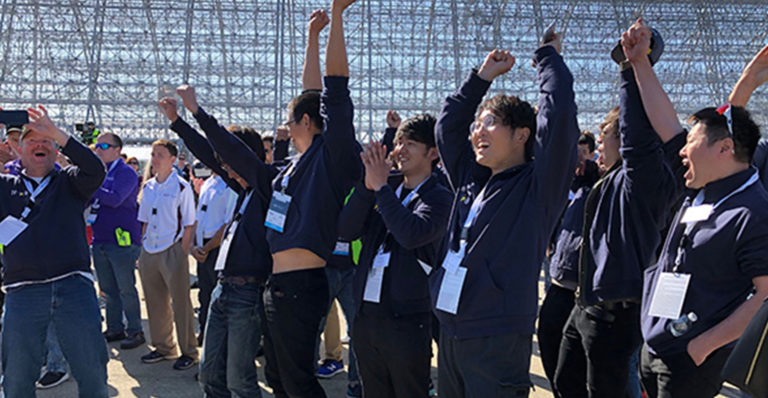There must be something in the water at the Delft University of Technology in the Netherlands. Home to the team that won the original SpaceX Hyperloop competition in January 2017 with the best overall pod, the university has produced another team of innovators ready to shake up the aviation space. Team Silverwing, one of five winners of Phase II of the GoFly Prize, has built an electric flying motorcycle designed for autonomous flight at speeds topping 60 mph.
Not surprisingly, Delft’s engineering and aerospace departments have become world famous, with faculty and staff involved in a number of high-profile projects. So when Silverwing Team manager James Murdza and technical manager Victor Sonneveld learned about the GoFly Prize and set out to build their device, the S1, the two had plenty of talent to recruit, including a few Hyperloop veterans.
Silverwing is one of the bigger teams to win Phase II of the GoFly Prize. It’s currently made up of about 30 members and counting, including students and professors from 10 different countries with expertise in eight different disciplines across six of the university’s engineering faculties. Despite its size, Silverwing is a tightly-knit family, Murdza says—a family unified in its aim to get their S1 prototype scaled up, fine-tuned and ready for GoFly’s Final Fly-Off in 2020.
Making Mentorship Count
Mentorship has played a critical role for Silverwing, as the team makes a continued effort to consult with university advisors, manufacturers, and GoFly Masters—including Dr. James Wang, senior vice president of Leonardo Helicopters and the former vice president of research and development at AugustaWestland. Known as the “Steve Jobs of Rotorcraft” by those in the industry, Wang has shared his expertise in helicopter design and advised Silverwing on how to design test flights and use different-scaled models to build up to a full-size version.
Meanwhile, when it came time to optimize the propellers for the S1, Silverwing turned directly to their manufacturer for insight. “We knew the company that made them would have the best insight into what would work, so they helped us find the right dimensions of the blades for our device. We’ve been working with manufacturers a lot in this respect, so you could say that they’ve become our advisors as well,” Murdza explains.
Internally, the team is brimming with subject matter experts too, including electrical engineers, industrial designers and aerospace professionals who were instrumental in building Delft’s Hyperloop pod. “There’s a tremendous amount of cross-collaboration and mentorship that takes place within the team, especially because we represent various education levels,” says Murdza.
This diversity of expertise has played a critical role in advancing Silverwing’s design. The suggested introduction of an aerodynamic shell around the pilot, for example, has tremendously reduced drag on the device and improved its performance. Even the orientation of the device has evolved. In its current iteration, the S1 is powered by two ducted fans that enable the device to sit on its tail for take-off and landing but rotate into a more horizontal position for flight. “There’s a lot of little detail tweaks we’ve made as well,” Murdza adds. “Small changes have made a big impact.”
Scaling and Soaring
For Silverwing, Phase II of the GoFly prize was all about testing and analysis. Because one of the Phase II requirements was to log actual flight time, the team was determined to get its half-scale model up in the air as much as possible. Yet even this large team struggled with the amount of time and volume of resources needed to execute successful test flights.
“When you test something for the first time, things break and then not only do you need time to fix them, but you also need new parts. It’s a complicated process,” Sonneveld explains. Still, Silverwing found ways to overcome challenges, tackling one hurdle at a time. “When the batteries we were using were presenting problems, we switched to a cable that made it easier to test flight. It’s all about isolating the problem and solving for it.”
The team also considers itself lucky because so far, things have managed to “work out,” just in the nick of time. But what Sonneveld attributes to luck is more likely the work of tireless perseverance. One “lucky” moment came just before the Phase II deadline when the team was executing a critical test of their new electric motor. Silvering knew they were cutting it close with testing, but logging the flight hours was vital, so they spent 12 hours in a freezing cold F-16 aircraft shelter testing the device—and it was a success. “It was a really tough day but the result was so satisfying. It made it all worth it,” Sonneveld says.
As Silverwing looks ahead to Phase III and the Final Fly-Off, Murdza, Sonneveld and rest of the team are eager to bring their full-size device to life. “It’s one thing to run prototype tests and simulations but to fly the real thing—we can’t wait for that moment,” Murdza says. And once the S1 is realized, the electronic helicopter’s applications will be vast, ranging from disaster response and offshore rescue operations to recreational use. “It will exceed the capabilities of any existing device,” says Murdza. “To fully understand its potential, you have to let your imagination run wild.”








